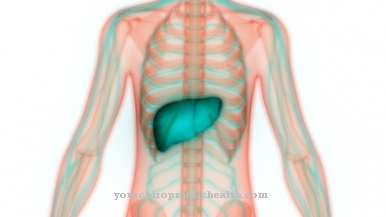The Axial migration In the blood flow, the deformable erythrocytes are displaced into the axial flow by means of shear forces close to the wall in smaller vessels. This creates marginal currents with few cells, which prevent stenoses in the capillaries. This effect is part of the Fåhraeus-Lindqvist effect and can be limited by changes in the shape of the red blood cells (erythrocytes).
What is axial migration?

The blood is a viscous liquid. The viscosity is a measure of the viscosity. The greater the viscosity, the more viscous the fluid. At a higher viscosity, the fluid components are more closely bound to one another and therefore more immobile. In this context, there is talk of internal friction.
In order to be able to reach all body tissues without problems and to be able to pass even through the thinnest capillaries, the human blood, unlike a Newtonian fluid, does not behave proportionally, but is of different viscosity due to the Fåhraeus-Lindqvist effect.
The Fåhraeus-Lindqvist effect relates to the decrease in apparent blood viscosity in vessels with decreasing vessel diameter. This change in viscosity prevents capillary stasis and is related to the axial migration of the erythrocytes.
During axial migration (in the blood flow), the deformable red blood cells migrate into the central stream due to shear forces close to the wall. This creates a marginal flow with few cells and the plasma flow around the cells can act as a sliding layer.
The Fåhraeus-Lindqvist effect and the associated axial migration of the erythrocytes is therefore the cause of the falling blood viscosity in narrow vessels in the circulatory periphery. In vessels with a larger lumen, the axial migration of the erythrocytes is canceled out and the blood appears more viscous.
Function & task
Newton's law applies to aqueous liquids. Since blood is a non-homogeneous suspension, its flow behavior does not follow Newton's law. Instead, its viscosity is a function of the shear stress. Slow flow speed increases viscosity.
The erythrocytes are primarily responsible for the adaptability of the blood viscosity. The blood cells are malleable and move around in an organized manner. At low flow speeds, they crowd together, similar to money in rolls of coins.
As soon as the shear stress drops extremely, the viscosity increases accordingly. In this situation, the blood has the properties of a solid. In contrast, higher shear stresses allow the blood to develop more fluid properties. High shear stress makes the blood more fluid and therefore more flowable.
Because of these relationships, there are viscosity differences for the blood in the aorta, with a large diameter, and in the narrow-lumen arterioles, with a very small diameter. In this context, the axial migration of the erythrocytes comes into play. The cells migrate into the central bloodstream as soon as the vessels narrow. The erythrocytes are capable of this migration because of their deformability.
Due to the axial migration of the erythrocytes, the effective viscosity in the narrow-lumen vessels of the periphery is about half as great as in the large-lumen vessels in the center of the body. These relationships are described in the Fåhraeus-Lindquist effect.
The shear forces close to the wall cause erythrocytes to be displaced into the axial flow and thus create a marginal flow with few cells. The surrounding plasma edge flow becomes a sliding layer in which the blood seems to flow more fluidly. The hematocrit thus reduces its influence on the peripheral resistance in vessels below 300 µm. The frictional resistance in these vessels is reduced.
Illnesses & ailments
The red blood cells can be affected by changes in shape under various circumstances that make it difficult for them to migrate axially in the blood flow. In the various types of anemia, the red blood cells change shape in characteristic ways. Differences in size between individual erythrocytes speak for anemia.
The erythrocytes often take on too large a shape in alcoholism. In addition to a larger diameter of over ten μm, they have an increased volume so that their axial migration can be disturbed. While the red blood cells in alcoholism usually retain a normal basic shape and only become enlarged macrocytes, they can completely lose their basic shape in other diseases.
Erythrocytes that are enlarged and appear oval at the same time are known as megalocytes and occur mainly in deficiency symptoms such as vitamin B12 or folic acid deficiency.
Erythrocytes that are too small with a diameter of less than seven μm have a reduced volume. If the reduced blood cells are otherwise normal, it is typically due to either iron deficiency or thalassemia.
In many forms of anemia there are strong deviations in the basic form, for example sickle cell anemia. Red blood cells sometimes transform into a ring shape in iron deficiency anemia. A club, pear or almond shape is present in all severe anemia.
Torn erythrocytes correspond to schistocytes and can occur after the use of artificial heart valves. Schistocytes also characterize bone marrow transplants and burns. Due to changes in shape, the erythrocytes lose their elasticity. The passage through narrow and curved vessels is no longer easy for shape-altered erythrocytes. The axial migration in the blood flow can thus be restricted by changes in the shape of the erythrocytes.
Since the red blood cells are recognized by the body as defective, they are broken down more intensely within the spleen. They should then replace the bone marrow with new erythrocytes. Since no well-formed erythrocytes can be reproduced in various deficiency symptoms and diseases, the anemia persists. The increased breakdown of red blood cells can be read from the small blood count.


























